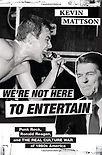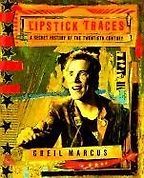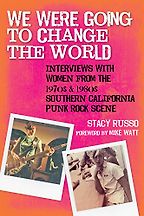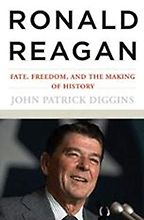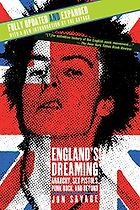Before we discuss your selected books, what is or what was punk rock?
What I address in my book is punk rock in the 1980s. And that’s why one of the books that I chose was solely about Ronald Reagan and not about punk rock itself. Punk has a long history. Historians debate as to when it really actually ‘begins’. There are some who point to the Lower East Side in New York City in the 60s and the Velvet Underground, the Fugs and other kinds of noisy bands. I actually prefer to say that the start of it all was in 1969, in Detroit, Michigan, with the rise of the MC5 (Motor City Five) and Iggy and the Stooges. And I emphasise that as a starting point because I’d like to move beyond the prevailing model of punk or any artistic expression being solely about Los Angeles or New York City or other so-called cultural capitals.
Citing its origins in the Midwest I think is important. Punk migrates and moves up through New York City, CBGB being the famous club where a lot of original punk acts performed: Patti Smith, the Ramones, Television, and many others. In my work I tried to not focus too much on CBGB because there’s been so much written about it, and it extends to a lot of what happened in the 70s. There is a decisive shift at the end of that decade. Patti Smith, for instance, drops out of music entirely in 1979. The band Blondie, which was closely connected with CBGB, hit the big time with their single “Heart of Glass”, and so you get a number one Disco song – a far cry from punk – that’s very popular.
Get the weekly Five Books newsletter
And so I think that by 1979 to 1980, things change and there’s a break to a certain extent. You see the rise of what were called teeny punks, kids in their teen years, who are basically entering music scenes, creating scenes, and very often much more suburban in terms of their background. So the 80s takes on a different feel to the music and movement of either the 70s or maybe even the late 60s. Punk has a long history, and my focus has been on what could be called its third chapter. The first would be the origins, then the 70s phase, and then I think it’s important to add on the 80s, the third chapter of punk, which was unique and different from what had come before it.
What motivated you to write your book about this chapter in the history of punk?
Well, it will probably come as no surprise to learn that I was a participant in the Washington DC punk scene in the 1980s. I always felt that it was misrepresented, even back then. And it’s still misrepresented in many people’s minds today. Looking back, in the 1980s there were all these awful television shows and movies that portrayed punks as mindless and violent, just aggressive and awful. One of the films that best typifies this cliché is called The Class of 1984, in which the punk kids have taken over the school, they wind up raping the pregnant wife of a school teacher, I mean, it’s just terrible. The image of punk in many circles back then was rather negative, to say the least. This was definitely a movement that was widely misrepresented. Some people still associate punk with a kind of cynical, violent nihilism. There are many books on Punk Rock. In my book I wanted to show that there were large elements of Punk during the 1980s that were the furthest thing you could imagine from that dark caricature.
The caricature of punk in some ways perhaps reflects the sum of all fears of established segments in society. Think back to the original reaction to the Sex Pistols or to anarchic acts prior to them.
I think that this third chapter of punk that extends into the 1980s is actually directly associated with the demise of the Sex Pistols. They broke up in acrimony in 1978, having formed only two years prior. Then their bassist Sid Vicious overdoses and takes leave of us on Earth. There was a shift. In my research I reviewed a ton of fanzines published at the time to investigate this shift. There are many people who remember the 1978 Winterland music performance that was the Sex Pistols’ last performance as both a kind of apogee and a nadir for the band. And that was in San Francisco, in the United States.
A few of the authors that you selected among punk rock books were in fact there for that final Sex Pistols concert in person.
These would be people who were probably a little bit older than the teeny punks that are really entering the scene in the early 1980s. The demise of the Sex Pistols opens up this new sort of vista. Arguably, Sid Vicious of the Pistols symbolises perfectly the punk portrayal as being nihilistic and dead end-ish. Whether or not he was sincerely a nihilist, or what have you, he was certainly a drug addict with a bent for self-destruction. He was a mess and his life was a mess. And he was violent. While the Pistols were touring the United States, he would go after people hitting them with his bass and engaging in all sorts of, well, viciousness. You can understand how those perceptions of punk as something that was crazy, out of hand, violent, nihilistic, might arise. I want to say that that’s different from what actually took place during the 80s.
Let’s talk about the first of the punk rock books in your selection, England’s Dreaming, which puts the Sex Pistols front and centre. It seems that almost everybody who saw them live, particularly in that fateful last concert in 1978, ended up forming a band of their own. They spurred the DIY ethic that Punk stood for. Were the Sex Pistols then a kind of seedbed for punk to really take root?
That’s right and that’s one of the things that the book England’s Dreaming does so well. It tells the story of the Sex Pistols’ formation and their demise, but also shows how many punk offspring the Sex Pistols had in Britain in the late 1970s and beyond in the 1980s. With this band there’s certainly a feeling of something being born.
You might say the converse about the second book in the lineup, Lipstick Traces, which rather than looking at the descendants of punk, traces its genealogy and finds all sorts of seemingly unlikely and unexpected affinities and echoes of earlier anarchic movements. This book was absolutely fascinating, and unexpected for a street culture like punk, a narrative history of art and rebellion throughout the 20th century. And, indeed, centuries prior.
Absolutely. One of the things that Marcus does, for example, is to bring to our awareness the Situationist International. Supposedly – although this is debatable – the Situationists were influential on Malcolm McLaren, the avaricious Sex Pistols manager. That’s perhaps apocryphal, but the fact of the matter is that the Situationist International, with its critique of spectatorship and of ‘The Spectacle’, as modern society was described by them, became a key theme that I believe had a profound influence on punk music. Its underlying message is one of DIY, to stop looking at your television screen, stop going to the movies and stop watching movies. To create your own culture rather than waiting for it to be handed down to you by the powers that be. In that act you become truly rebellious. Even though it was an international organisation, it was based in France and was very French in spirit.
“Punk was a movement with a lot of humour at heart”
This comes across in Lipstick Traces, although I remember from my own research for my book that Marcus also authored a series of articles that he did for the Village Voice in the early 1980s in which he brought the parallels to light. He was one of the first people to try to explain the Situationist International – not an easy task! Especially if you’re reading them for the first time, there’s all sorts of Marxist jargon that’s difficult to penetrate. But Marcus convincingly made the link between punk and the Situationist International, and in the process explained this arcane philosophy, which is no small feat. Not something that other punk rock books even attempted!
That sets us up for a discussion of both the Dead Kennedys and Ronald Reagan, which in your telling almost feel like two sides of the same coin. The presidency of Reagan was almost the embodiment of ‘The Spectacle’ in the Situationist sense. I’m reminded of that great Frank Zappa quote: “Politics is the entertainment division of the military industrial complex”. In Reagan we had a Hollywood actor who had become the commander in chief. The West Coast band the Dead Kennedys were railing precisely against this very Reaganite, conservative American spectacle, and the third book deals directly with one of their most famous albums, Fresh Fruit For Rotten Vegetables.
That’s right, the country’s turning. If there’s a new chapter of punk as we move from 1979 to 1980, the country is also turning the page to a new chapter and moving to the right with the successful election of Ronald Reagan and the defeat of Jimmy Carter. Michael Foley’s book about the Dead Kennedys does a really good job of teasing out the kind of political and social criticism that was quite serious on the part of the Dead Kennedys, with an element of shock and surprise, but also with humour. One of the things that’s important to keep in mind is that punk wasn’t just dire seriousness, whether it was criticising the Queen of England or criticising America as it existed under the presidency of Ronald Reagan. Punk was a movement with a lot of humour at heart. Much of it dark humour, gallows humour, but equally a humour tempered by an understanding of theory or a political earnestness or seriousness of someone like the Dead Kennedys’ lead singer, Jello Biafra.
Get the weekly Five Books newsletter
It’s probably significant that they were formed in 1978. Here again we find a direct temporal linkage to the demise of the Pistols, not just to the creation of the Kennedys but to a lot of other very influential bands on the West Coast of the United States.
It is significant. The Sex Pistols’ final act in San Francisco was witnessed by many people who were in bands or went on to create bands. The Dead Kennedys crystallised out of that as well. On the West Coast, an earlier generation of musicians, numerous bands formed in the 1970s, basically call it quits in the last 70s, most famously the Avengers. This opened up a path for new bands like the Dead Kennedys to become even more dominant – although they would probably balk at the term – within the San Francisco scene. I’ve noted that one of the things that Jello Biafra gets very, very excited about is when he started seeing the composition of the audience changing toward an ever younger crowd coming in as we move into the 1980s. It’s not quite generational, because I don’t think it’s that big of an age difference, but it had the feeling of being something different. There’s new blood coming onto the scene that hadn’t been there before, perhaps as they were only just coming of age. It lends the scene a new energy.
That was certainly the case for me. As a young teen, I didn’t have enough pocket money to take the trips to go and see these mythical bands as they toured around the country. One argument that really struck me in Foley’s book is the underlying argument that to attend a concert by a band like the Dead Kennedys can be a formative political experience for a generation of citizens, almost akin to attending a rally or a convention.
Whenever he performed in theatres in San Francisco or as the Kennedys started to tour the United States, Jello Biafra would always make it a point to say things to the audience like, ‘Go out and read a book!’. Don’t stop here, when the concert ends. We the Kennedys are gonna pummel you with political criticism, but don’t take our word for it, think for yourself, go to a library and read some political theory! The other thing that I really enjoyed discovering was another of the most pioneering bands for this generation of teeny punks, the Minutemen. They were notorious when they toured. But not for the reason that the Sex Pistols were notorious. They would hit the tour circuit, going what they called ‘jam econo’ by doing it all as cheaply as possible – driving a van, crashing on people’s couches, doing their performance and moving on to the next town. On the way, they are said to have gotten into these huge arguments. Typically, it was the lead singer D. Boon versus their bass player Mike Watt in epic arguments about things like the finer points of British history. They would literally head into a town, stop the van and go to a library to resolve their debates. That’s so punk rock! It’s just a marvellous story.
“It was about disagreements concerning the way we look at the world”
This anecdote maybe also illustrates why this sort of movement could never be successful ever again. The Internet has changed that sort of autodidactic experience that I believe a lot of the people involved in that scene were dedicated to. It also shows up the typical stereotype for being much more than just a kind of violent thug culture. Read the lyrics of Dead Kennedys songs and they are brimming with biting, well-informed social and political satire.
The other thing I loved about this book is the 33 1/3 format, a book about an album. I’ll be keen to explore a few others. What a great concept.
There’s a great volume called Double Nickels on the Dime, the title of the Minutemen’s double album that was released in 1984. It’s an excellent book which explores the ideas and historic background of the movement. One thing to keep in mind was that my official training in graduate school was American intellectual history. I’m probably being audacious in saying so, but I actually believe that punk zeroed in on powerful ideas. This was intellectual life. It was young and riotous, but it was an intellectual life. Perhaps it wasn’t as well informed or articulated as we would expect intellectual life to be, but it was about ideas, it was about debates. It was about disagreements concerning the way we look at the world. This perhaps is the most forgotten or misunderstood aspect of punk rock, if indeed it was ever understood in the first place.
One of the challenges you must have encountered in your research is the very ephemeral nature of a lot of the archival material: fanzines, posters, articles in local papers. I admire your tenacity in assembling this material.
Or my insanity more like…!
Stacy Russo, in her book We Were Going to Change the World accomplishes a similar archival feat in assembling some very interesting material that might otherwise be lost, not just to the Academy, but to a wider understanding of this moment in music.
Absolutely. One of the ghastly things is that people are selling their archival material on the market rather than depositing valuable records at places where scholars and others who simply have an interest in this sort of stuff can go through and peruse them. That’s one of the crimes that I discovered as I wrote my book, the many people who have sold precious archives that I didn’t otherwise have access to. One advantage that I devised was to use Maximumrocknroll, a nonprofit monthly zine of punk subculture founded in 1982 and based in San Francisco, as a way of cross-checking what was going on in other cities in the US. If I came across word of a fanzine that was say, out of Tulsa, Oklahoma – which believe it or not had a profound political punk scene – I would test by seeing if Maximumrocknroll was talking about it.
Needless to say, I would also sometimes, trying not to do this too often, deploy the ‘bullshit detector’. Of course I didn’t remember every single moment of my engagement in the scene and what I knew was going on nationally, but I had enough experience of it to be able to crack through the thin veneer of the evidence and say, ‘OK, yes, this is something significant’. Russo’s book does this very well, and that’s one of the reasons that I chose it for my selection.
The dominant way of writing punk history is to compile interviews alone. Some of your readers may be surprised at one of the books I did not include in my list, which is Please Kill Me, just a series of interviews with people on the scene pasted together. I find that sort of oral history to be dangerous. I don’t trust people’s memory. I don’t even trust my own memory!
There’s also clearly a risk of people promoting their own agenda or skewed perspective via their reminiscences….
Exactly, you’ve got to know where people are coming from. It’s the music scene, and so you will always find self-aggrandisement somewhere, that ‘I was there for the formation of this or that or that band’ or whatever. What Russo does so well is to blend together the memoirs and the evidence which allows for a longer narrative rather than just a paragraph statement from any given individual. Like the author here that I suppose I most admire, Jon Savage, there’s a narrative development that goes beyond oral history. England’s Dreaming is such a good book because it’s not merely an oral history. He did conduct interviews, of course, and these have been released uncut in a follow-up edition, the England’s Dreaming Tapes. But for the most part, he’s going back to the record and recreating events in a way that’s actually quite alarmingly literary. It’s a beautifully written book. That’s no exaggeration.
“Punk isn’t just about music. It’s about building a wider popular movement”
One of the things that I wanted to reject and not fall prey to in my own work was the reliance on oral interviews with the participants. I kept that to an absolute minimum, and only contacted people and interviewed them when I couldn’t find a specific piece of ephemera, be it a zine, poster, bootleg recording, or a booklet attached to a record or something like that. True primary sources were key, and only having exhausted these I might consider an interview. Even when I did those interviews, I was quite hesitant about relying upon the person’s memory and what the person wanted to convey to me in terms of what they saw as being significant.
We Wanted to Change the World is also striking for its levity. There’s a light-heartedness that Russo conveys about the scene that counteracts the prevailing stereotype of punk being all dark and negative. What comes across very clearly in these pages is the extent to which it was an inclusive, even celebratory movement.
The levity is a common thread in almost every single interview she chose for this book. Many of the protagonists say that this was an act of politicisation, that they became politically aware though Punk Rock. In my book too it’s one of the things that I wanted to emphasise. Punk isn’t just about music. It’s about building a wider popular movement that can include engagement in politics in different ways than was possible before. You can see this in the art of the time, you can see it in movies, you can see it in many different forms of self-expression.
Something else that gets overlooked is the extent to which women were very much a driving force in the early days of punk. Bands like the Runaways, the Slits, the Stilettos may be less well known than the artists they gave rise to – Debbie Harry, Chrissie Hynde, Joan Jett, all of whom became household names in the years that followed.
I wanted to get away not only from the over-reliance on oral history which dominates the study of punk, but also the way in which we usually tell the story as a narrative of different bands, their playlists and their members. This is an approach that usually silos things rather than giving you a wider perspective on what makes punk truly interesting as a social phenomenon. The forms of creativity that punk mobilised were much more diverse and inclusive than I believe people recognise.
In these books, you also draw out the repercussions and refractions of punk rock across a range of the arts. Rifling through the pages of a favourite among punk rock picture books, Punk 365, you stumble across Burroughs hanging out with Allen Ginsberg and Andy Warhol, we see film-maker Jim Jarmusch and artist Raymond Pettibon, famous for his Black Flag covers and now represented by mega-gallery David Zwirner. Also a writer like William Gibson, who found a lot of his formative ideas in this movement during this period.
Another important artist here is Winston Smith, who did a lot of the Dead Kennedys’ promotional materials. Like Pettibon, he was knowledgeable about art history and the history of the avant-garde in modern pictures and painting. Pettibon would take part in the epic Minutemen discussions with Mike Watt, for example, in recounting the story of Surrealism, Dada and how they influenced him as an artist. He had this wonderful way of doing things where his technique would confront the viewer with a radical disjuncture – between the actual image and then the accompanying text, usually written either above or below in such a way as to be a provocation and a puzzle. This was part of what made him successful and it’s part of the power of punk. Like Winston’s cover art, Pettibon makes you sit up and say, ‘What is this?’.
Five Books interviews are expensive to produce. If you're enjoying this interview, please support us by donating a small amount.
The iconography was in large part about the death of hippie culture and the hippie movement, along with the rise of key personalities in the 60s counterculture, like Charles Manson, the insane organiser of what he called ‘the family,’ which was mostly manipulated young women who went on murder sprees for him. This is intelligent, interesting, urgent, neck-snapping art that he created. Winston Smith in visual terms was continuing and innovating with a technique for cut ups that takes us back to Dada and the literary work of writers like William S. Burroughs, not to mention of course the Situationist International.
Speaking of jarring juxtapositions, let’s talk about Ronald Reagan! Punk was a kind of rage against the machine, the all-devouring beast of modern consumerist society, which arguably Reagan’s America came to exemplify. For your final entry among punk rock books, why did you choose Diggins’s book on Reagan? It almost reads like a hagiography, describing Reagan as one of two or three great presidents after Lincoln.
This is a work of intellectual history and history of ideas, as opposed to a settling of scores or taking account of the Reagan presidency. It’s not unimportant, making sense of the politics, but I just didn’t find it as interesting as trying to get inside a president’s worldview. Diggins goes so far as comparing Ronald Reagan to Ralph Waldo Emerson, which is just remarkable! I totally disagree with the interpretation, but I do recognise how many Americans probably saw Reagan in this light. My favourite episode described in this book is welcoming Michael Jackson to the White House, when Ronald Reagan goes on record as saying, ‘What a Thriller it is to have you here…!’. He’s flagrantly showing off just how much he’s indebted to celebrity culture for his status, which is something that absolutely no self-respecting punk in the 80s would ever saddle up to. With his almost foolish obsession with dreaming and optimism Reagan was a Romanticist, and I think Diggins is right to draw this out. The more important question is obviously whether or not one thinks that he was a good or even fitting head of state.
Celebrity of course is anathema for punks. Any whiff of success becomes a sure sign of selling out, of corruption, and celebrity has to be the ultimate sellout, compared to the sort of authenticity that punk was striving for.
Kill your idols. Which I don’t think is a literal statement! But anybody who appears as a celebrity or as a star deserves rejection and ridicule in the punk worldview.
‘Anger is an energy’, sang John Lydon (aka Johnny Rotten) of Public Image Ltd in 1986. There’s lots to be angry about still today. America in particular, seems to have become a society that is the apotheosis of The Spectacle. So who are the anarchists, the true heirs of punk today?
That’s difficult to say, as these things often only come to light in retrospect. For sure, there are hip hop artists who are writing brutally critical songs about Trump’s America. If we consider the DIY ethic of punk, this also seems to be very much alive and well. When asked this question I often give an example that’s very local to me. Early in the pandemic, which we’re still going through, just a block away from where I live, neighbourhood citizens put together a spontaneous recurring performance where people will sit in their front yards and play music to one another. All the while they are social distancing, and using masks and taking relevant precautions, but they are without a doubt creating their own culture. To the extent that there is a central theme of my book, it’s the call to act, to create your own culture. Creating your own culture also changes your consciousness. Channelling one’s anger against the triteness of the culture industry’s offerings can be an organic, spontaneous and creative act of resistance and rebellion. That’s probably the best place to look for the successor to punk in the 80s.
Five Books aims to keep its book recommendations and interviews up to date. If you are the interviewee and would like to update your choice of books (or even just what you say about them) please email us at [email protected]

